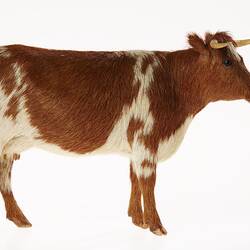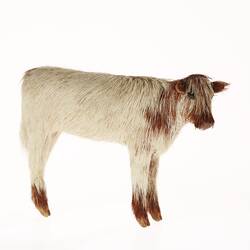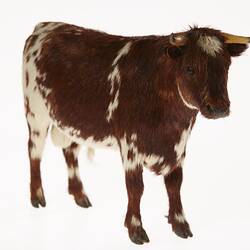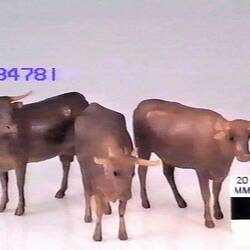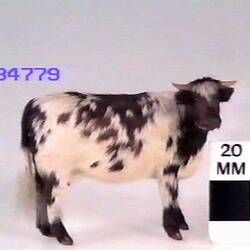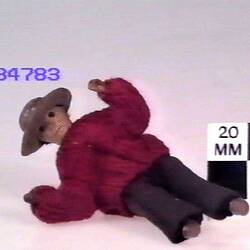Summary
Model of standing cow, possibly Ayrshire breed.
The model was by Mrs Mary Jane Penrose Johnston (nee Gore) of Armidale, New South Wales (1858-1944). Mrs Penrose Johnston began model making with her two sisters Martha and Wilhelmina during their childhood. Martha married Gustave Drabsch in 1878, and Whilhelmina married John Jurd in 1886. Mary Jane Penrose-Johnston first exhibited in 1879 at the Sydney Exhibition, receiving a 'Highly Commended' for the beeswax models of four cows. Mrs Penrose-Johnston continued to make the model animals into her old age - her great-great-granddaughter remembers her 'working at the models by lamplight, even in the last five years of her life'.
Physical Description
Model of standing cow, brown and white, with horns. The model consists of a paper mache armature, shaped with beeswax, and red and white coat consisting of cow hair. The eyes are probably made of glass, with ears, udders & hooves of wood. Horns are made from real horn whittled down to size. Scale approx. 1:12.
Significance
In the 1879 Sydney Exhibition, three sisters from Armidale, New South Wales, Mary, Martha and Wilhemina Gore, were highly commended for their beeswax models of four cows. This was the first public display of what became for Mary Gore (later Mrs Penrose Johnston, 1858-1944) a lifetime hobby.
Mary Jane Gore was born in 1858 and married James Johnston, a dairy farmer from Armidale. She developed a technique of making miniature farm animals, first using a clay core, wrapping it with brown paper, then adding a beeswax surface which was soft and easily modelled. Ears and horns, doll's eyes and the fur or fleece were added later. The accurate patterns on the cow's hide were made using tweezers, applying several hairs at a time. She received an Honourable Mention in the Centennial International Exhibition in Melbourne, 1888, for a model of a cow; and she won First Prize at the Brisbane Show in 1912 for her 'Miniature Cattle Ranch'.
More Information
-
Collecting Areas
-
Acquisition Information
Donation from Mrs Elizabeth A. Fry, 09 Dec 1969
-
Modelmaker
Mrs Mary J. Penrose Johnston, Armidale, New South Wales, Australia, 1879-1944
-
Classification
-
Category
-
Discipline
-
Type of item
-
Overall Dimensions
180 mm (Length), 70 mm (Width), 120 mm (Height)
-
References
Jennifer Isaacs: 'The Gentle Arts: 200 years of Australian women's domestic and decorative arts', p.200 - 201. Dictionary of Australian Artists Online [Link 1] Young, Linda (1984), 'Bush waxwork: The Gore cows', Australiana Society Newsletter, 01-01. (1880), 'Official Record of the Sydney International Exhibition', Sydney, NSW. (1880), Sydney Morning Herald, 03-19.
-
Keywords
Cattle Husbandry, Cows, Dairy Husbandry, Farm Animals, Modelmaking




